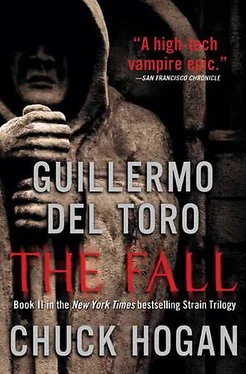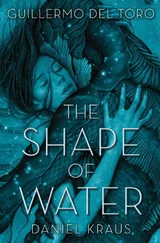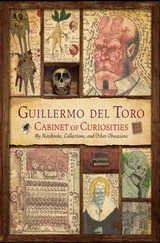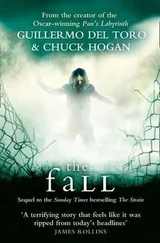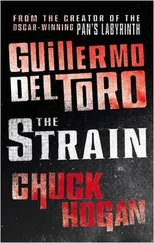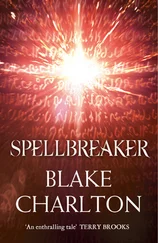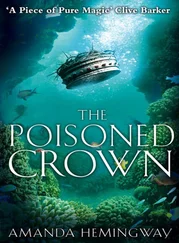Gus slung the weapons bag onto his shoulder. “Come on. You don’t want to miss this.”
He was easy to follow, because Quinlan had cleared a path of downed branches, pointing the way straight ahead, weaving only for tree trunks. They hustled along, coming upon Quinlan in a clearing on the other side, finding him standing quietly with the gun cradled against his chest.
His hood had fallen back. Creem, huffing, saw the driver’s smooth bald head from behind. In the darkness, it looked like the guy had no ears. Creem came around to see his face better — and the human tank shivered like a little flower in a storm.
The thing called Quinlan had no ears and barely any nose left. A thick throat. Translucent skin, nearly iridescent. And blood-red eyes — the brightest eyes Creem had ever seen — set deep within his pale, smooth head.
Just then a figure broke from the upper branches, dropping to the ground with ease and loping across the clearing. Quinlan sprinted out to intercept it like a cougar tracking a gazelle. They collided, Quinlan dropping his shoulder for an open-field hit.
The figure went down sprawling with a squeal, rolling hard — before popping right back up.
In an instant, Quinlan turned the barrel light on the figure. The figure hissed and flailed back, the torture in its face evident even from that distance. Then Quinlan pulled the trigger. An exploding cone of bright silver buckshot obliterated the figure’s head.
Only — the figure didn’t die like a man dies. A white substance geysered out from its neck trunk and it tucked in its arms and collapsed to the ground.
Quinlan turned his head fast — even before the next figure darted from the trees. A female this time, racing away from Quinlan, toward the others. At the others. Gus pulled the scimitar from the bag. The female — dressed in tatters like the filthiest crack whore you’ve ever seen, except that she was nimble and her eyes shone red — reeled back from the sight of the weapon, but too late. With a single, clean move, Gus connected with the tops of her shoulders and her neck, her head falling one way, her body the other. When it all settled to the ground, a pasty-white liquid oozed out of her wounds.
“And there’s the white,” Gus said.
Quinlan returned to them, pumping the long gun and raising his thick cotton hood back over his head.
“Okay, yeah,” said Creem, dancing from side to side like a kid who had to go to the bathroom on Christmas morning. “Yeah, I’d say we’re fucking in.”
The Flatlands
Using a straight razor taken from the pawnshop, Eph shaved half his face before losing interest. He zoned out, staring into the mirror over the sink of milky water, his right cheek still covered in foam.
He was thinking of the book — the Occido Lumen — and how everything was going against him. Palmer and his fortune. Blocking every move they could make. What would become of them — of Zack — if he failed?
The edge of the razor drew blood. A thin nick turning red and flowing. He looked at the blade with the smear of blood on the steel, and drifted back eleven years to Zack’s birth.
Following one miscarriage and a stillbirth at twenty-nine weeks, Kelly had been on two months’ bed rest with Zack before going into labor. She had a specific birth plan going in: no epidural or drugs of any kind, no cesarean section. Ten hours later, there was little progression. Her doctor suggested Pitocin in order to speed things up, but Kelly declined, sticking to her plan. Eight hours of labor later, she relented, and the Pitocin drip was begun. Two hours after that, after enduring almost a full day of painful contractions, she finally consented to an epidural. The Pitocin dose was gradually increased until it was as high as the baby’s heart rate would allow.
At the twenty-seventh hour, her doctor offered her the option of a cesarean, but Kelly refused. Having given in on every other point, she held out for natural birth. The fetus’s heart monitor showed that it was doing okay, her cervix had dilated to eight centimeters, and Kelly was intent on pushing her baby out into the world.
But five hours later, despite a vigorous belly-massage from a veteran nurse, the baby remained stubbornly sideways, and Kelly’s cervix was stuck at eight. The pain of the contractions was registering now, despite the successful epidural. Kelly’s doctor rolled a stool over to her bedside, again offered her a cesarean. This time Kelly accepted.
Eph gowned up and accompanied her to the glowing white operating room through the double doors at the end of the hall. The fetal heart monitor reassured him with its swift, metronomic tock-tock-tock. The attending nurse swabbed Kelly’s swollen belly with yellow-brown antiseptic, and then the obstetrician sliced left to right low on her abdomen with confident, broad strokes: the fascia was parted, then the twin vertical belts of the beefy abdominal muscle, and then the thin peritoneum membrane, revealing the thick, plum wall of the uterus. The surgeon switched to bandage scissors so as to minimize any risk of lacerating the fetus, and made the final incision.
Gloved hands reached in and pulled out a brand-new human being — but Zack was not yet born. He was “in the caul,” as they say; that is, still surrounded by the filmy, intact amniotic sac. It ballooned like a bubble, an opaque membrane encircling the fetal infant like a nylon egg. Zack was still, in that moment, feeding off Kelly, still receiving nutrients and oxygen through the umbilical cord. The obstetrician and attending nurses worked to retain their professional poise, but Kelly and Eph both felt their apparent alarm. Only later would Eph learn that caul babies occur in fewer than one in a thousand births, with the number rising into the tens of thousands for babies not born prematurely.
This strange moment lingered, the unborn baby still tethered to his exhausted mother, delivered and yet unborn. Then the membrane spontaneously ruptured, peeling back from Zack’s head to reveal his glistening face. Another moment of suspended time… and then he cried out, and was placed dripping onto Kelly’s chest.
Tension lingered in the operating room, mixed with obvious joy, Kelly pulling at Zack’s feet and hands to count the digits. She searched him thoroughly for signs of deformity, and found only joy. He was eight pounds even, bald as a lump of bread dough and just as pale. His Apgar score was eight after two minutes, nine after five minutes.
Healthy baby.
Kelly, however, experienced a big letdown postpartum. Nothing as deep and debilitating as true depression, but a dark funk nonetheless. The marathon labor was so debilitating that her milk did not come in, which, combined with her abandoned birth plan, left her feeling like a failure. At one point, Kelly told Eph that she felt she had let him down, which mystified him. She felt corrupted inside. Everything in life had come so easily, to both of them, before this.
Once she got better — once she embraced the golden boy who was her newborn son — she never let Zack go. She became, for a time, obsessed with the caul birth, researching its significance. Some sources claimed the oddity was an omen of good luck, even forecasting greatness. Other legends indicated that caul-bearers, as they were known, were clairvoyant, would never drown, and had been marked by angels with shielded souls. She looked for meaning in literature, citing various fictional caul-bearers, such as David Copperfield and the little boy in The Shining. Famous men in real life, such as Sigmund Freud, Lord Byron, and Napoleon Bonaparte. In time, she came to discount all negative associations — in fact, in certain European countries it was said that a child born with a caul might be cursed — countering her own unfortunate feelings of inadequacy with the determination that her boy, this creation of hers, was exceptional.
Читать дальше
Конец ознакомительного отрывка
Купить книгу
